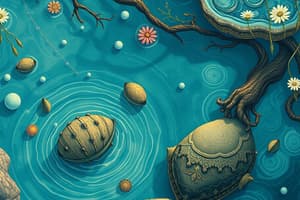Podcast
Questions and Answers
What percentage of the earth's surface is covered by water?
What percentage of the earth's surface is covered by water?
- 71% (correct)
- 30%
- 50%
- 90%
Which type of water source makes up about 99.7% of the earth's water?
Which type of water source makes up about 99.7% of the earth's water?
- Freshwater
- Salt water (correct)
- Groundwater
- Rainwater
What is the key challenge addressed by desalination facilities?
What is the key challenge addressed by desalination facilities?
- Recycling wastewater
- Converting salty water into freshwater (correct)
- Extracting groundwater
- Purifying rainwater
Why has water conservation become increasingly crucial according to the text?
Why has water conservation become increasingly crucial according to the text?
Which sector accounts for almost half of all global water withdrawals according to the text?
Which sector accounts for almost half of all global water withdrawals according to the text?
What do conservation efforts aim to achieve?
What do conservation efforts aim to achieve?
What is a recommended strategy for reducing water loss in agriculture?
What is a recommended strategy for reducing water loss in agriculture?
Which household practice is suggested to contribute to water conservation?
Which household practice is suggested to contribute to water conservation?
What can help optimize water usage in agriculture?
What can help optimize water usage in agriculture?
Which factor contributes significantly to water pollution?
Which factor contributes significantly to water pollution?
What can help combat water pollution caused by human activities?
What can help combat water pollution caused by human activities?
What action can help preserve groundwater quality?
What action can help preserve groundwater quality?
Flashcards are hidden until you start studying
Study Notes
Understanding Water Sources: Percent of Salt Water, Conservation, and Pollution
Introduction
Water is an indispensable resource for life, both for humans and the planet's ecosystems. Ensuring adequate water availability and quality is crucial for maintaining a healthy balance in our environments. In recent times, several factors, including climate change, population growth, and industrialization, have posed significant challenges to water resources worldwide. This article delves into the three main subtopics concerning water sources: the percentage of salt water, water conservation practices, and water pollution.
Percentage of Salt Water
Approximately 71% of the earth's surface is covered by water, but only about 0.2% of it is fresh and readily available for consumption and agriculture. The remaining 99.7% consists of salty water found mainly in oceans, which cannot be used directly for human consumption or agriculture without extensive desalination processes. Desalination facilities convert salty water into freshwater, providing additional sources of potable water to water-scarce areas.
Water Conservation
With the global population projected to reach almost 10 billion people by 2050, water conservation has become increasingly crucial to ensure that we sustainably manage our available freshwater resources. A few key areas where conservation efforts can be made include:
Agriculture
Agricultural systems account for nearly half of all global water withdrawals. By investing in drip irrigation systems, farmers can reduce water loss due to evaporation and runoff. Additionally, planting drought-resistant crops and using soil moisture sensors can help optimize water usage.
Urban Areas
Cities, home to more than half the world's population, play a significant role in water consumption. Improving municipal water management practices can result in substantial water savings. Fixing aging infrastructure, such as leaking water mains, can prevent significant water loss.
Household Practices
Simple lifestyle adjustments at home can contribute to overall water conservation. For instance, taking shorter showers, turning off the faucet while brushing teeth, and using a dishwasher instead of hand washing can significantly reduce water consumption.
Water Pollution
Poor sanitation, waste disposal, and industrial activities are key contributors to water pollution. Contaminated water sources can lead to severe health issues for humans and aquatic life. Efforts to combat water pollution include:
Regulation Enforcement
Strict enforcement of environmental regulations and monitoring of industrial effluents can help reduce water pollution caused by human activities.
Green Solutions
Preserving forests and wetlands helps maintain natural filtration systems that cleanse groundwater sources.
Technological Advancements
Developing wastewater treatment plants and desalination facilities can help purify water sources that would otherwise remain contaminated.
Conclusion
As societies strive towards sustainability and equitable resource allocation, understanding and addressing the challenges surrounding water sources becomes paramount. By better managing existing freshwater resources, investing in unconventional water sources, and combatting water pollution, we can work towards ensuring the future availability and quality of our planet's most essential resource for life: water.
Studying That Suits You
Use AI to generate personalized quizzes and flashcards to suit your learning preferences.




